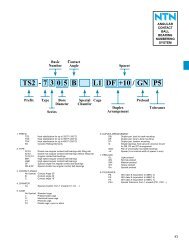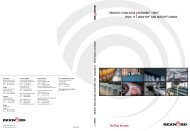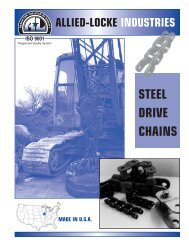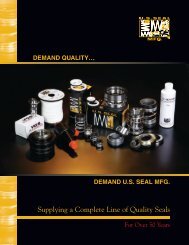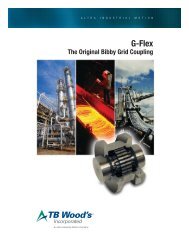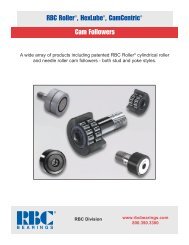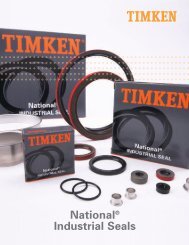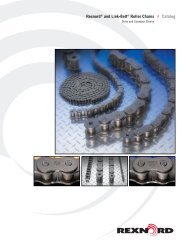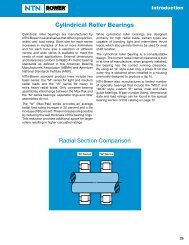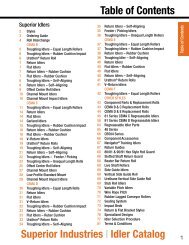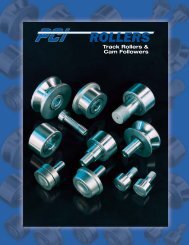LEESON / LINCOLN Motor Catalog - Norfolkbearings.com
LEESON / LINCOLN Motor Catalog - Norfolkbearings.com
LEESON / LINCOLN Motor Catalog - Norfolkbearings.com
Create successful ePaper yourself
Turn your PDF publications into a flip-book with our unique Google optimized e-Paper software.
TECHNICAL INFORMATION<br />
motor selection<br />
Electric motors are the workhorses of industry. Many applications exist<br />
where more than one motor can be used and/or the exact replacement is<br />
not available. <strong>LEESON</strong> makes every effort to maximize interchangeability,<br />
mechanically and electrically, where <strong>com</strong>promise does not interfere with<br />
reliability and safety standards. If you are not certain of a replacement<br />
condition, contact any <strong>LEESON</strong> Authorized Distributor or the <strong>LEESON</strong><br />
District Sales Office.<br />
SELECTION<br />
Identifying a motor for replacement purposes or specifying a motor for new<br />
applications can be done easily if the following information is known:<br />
1. Nameplate Data 3. Electrical and Performance Characteristics<br />
2. <strong>Motor</strong> Type 4. Mechanical Construction<br />
TYPICAL SPEED TORQUE CURVES<br />
Capacitor Start/Induction Run<br />
A single phase general purpose design, with an<br />
electrolytic capacitor in series with the start winding,<br />
offering maximum starting torque per ampere.<br />
A centrifugal switch removes the auxiliary winding<br />
and capacitor when the motor approaches full<br />
load speed. The design is a heavy-duty unit which<br />
has approximately 300% (of full load) starting<br />
torque. Common applications include <strong>com</strong>pressors,<br />
pumps, conveyors and other “hard-to-start”<br />
applications.<br />
Capacitor Start/Capacitor Run<br />
This design has two capacitors of different values. A centrifugal switch is<br />
used to remove the electrolytic capacitor when the motor approaches full<br />
load speed. A second run capacitor remains in series with the auxiliary winding<br />
during full load operation. This type of design has lower full-load amps<br />
as a result of the run capacitor and is consequently used on most higher<br />
horsepower single phase motors.<br />
Permanent Split Capacitor (PSC)<br />
This design has an auxiliary winding with a<br />
“run” capacitor, but unlike the capacitor start/<br />
induction run motor, the capacitor and auxiliary<br />
winding remain in the circuit under running conditions.<br />
(There is no centrifugal switch on this type<br />
motor.) A permanent split capacitor design has low<br />
starting torque and low starting current. They are<br />
generally used on direct-drive fans and blowers.<br />
They can also be designed for higher starting<br />
torque and intermittent applications, where rapid<br />
reversing is desired.<br />
ELECTRICAL AND PERFORMANCE<br />
CHARACTERISTICS<br />
One of the best ways to guarantee economical performance and long<br />
motor life is to make sure your motors operate at nameplate voltage.<br />
Applying too high a voltage may reduce the motor’s efficiency and<br />
increase operating temperatures. The net result is shorter motor life.<br />
Under-voltage can also shorten motor life. Operating on too low a voltage<br />
reduces the motor’s effective horsepower. The motor will attempt to drive<br />
the load it was intended to drive, be<strong>com</strong>e overloaded, draw more current<br />
than normal, and overheat. Again, the result will be premature failure.<br />
ENCLOSURES AND ENVIRONMENT<br />
DRIP-PROOF: Venting in end frame and/or main frame located to prevent<br />
drops of liquid from falling into motor within a 15˚ angle from vertical.<br />
Designed for use in areas that are reasonably dry, clean, and well ventilated<br />
(usually indoors). If installed outdoors, it is re<strong>com</strong>mended that the motor be<br />
protected with a cover that does not restrict the flow of air to the motor.<br />
TOTALLY ENCLOSED AIR OVER (TEAO): Dust-tight fan and blower duty<br />
motors designed for shaft mounted fans or belt driven fans. The motor must<br />
be mounted within the airflow of the fan.<br />
TOTALLY ENCLOSED NON-VENTILATED (TENV): No vent openings,<br />
NAMEPLATE DATA<br />
Nameplate data is the most important first step in determining motor<br />
replacement. Much of the information needed can generally be obtained<br />
from the nameplate of the motor to be replaced. Take time to record all the<br />
nameplate information because it can save time, avoid confusion and<br />
MISAPPLICATION.<br />
MOTOR TYPE<br />
Alternating current (AC) induction motors are divided into two electrical<br />
categories, based on power source—single phase and polyphase (three<br />
phase). Direct current (DC) motors are used in applications where precise<br />
speed control is required or when battery or generated direct current is the<br />
available power source.<br />
Three Phase or Polyphase<br />
General purpose three phase motors have<br />
different electrical design classifications as<br />
defined by NEMA. NEMA Design A and B<br />
motors are of normal starting torque with<br />
normal starting current. NEMA Design C<br />
motors have higher starting torque with<br />
normal starting current. All three types have<br />
slip of less than 5%. (“Slip” being a term<br />
which expresses, as a percentage, the difference<br />
between synchronous motor speed<br />
and full load motor speed, for example, 1800<br />
rpm synchronous versus a full load speed of<br />
1740 rpm.<br />
NEMA’s Design B and C standards are minimum performance standards.<br />
In practice, some manufacturers (including <strong>LEESON</strong>) build small integral<br />
HP Design B motors with locked rotor and breakdown torque levels equalling<br />
NEMA Design C standards.<br />
NEMA T frame motors 1 through 200 HP covered by EPACT (identified<br />
with a “G” catalog prefix) are labeled Design B, exceed NEMA Design<br />
B performance levels, and have efficiencies equal to EPACT mandated<br />
levels. EPACT exempt three phase, base-mounted motors are labeled<br />
Design C and have performance characteristics meeting NEMA’s Design<br />
C standards, with standard motor efficiencies. <strong>Motor</strong>s 250 HP and<br />
larger are exempt from EPACT legislation.<br />
Permanent Magnet DC<br />
This design has linear speed/torque<br />
characteristics over the entire speed range.<br />
SCR rated motor features include high starting<br />
torque for heavy load applications and<br />
dynamic braking, variable speed and reversing<br />
capabilities. Designs are also available<br />
for use on generated low voltage DC power<br />
or remote applications requiring battery<br />
power.<br />
tightly enclosed to prevent the free exchange of air, but not airtight. Has<br />
no external cooling fan and relies on convection for cooling. Suitable for<br />
use where exposed to dirt or dampness, but not for hazardous (explosive)<br />
locations.<br />
TOTALLY ENCLOSED FAN COOLED (TEFC): Same as the TENV except<br />
has external fan as an integral part of the motor, to provide cooling by<br />
blowing air around the outside frame of the motor.<br />
TOTALLY ENCLOSED, HOSTILE AND SEVERE ENVIRONMENT<br />
MOTORS: Designed for use in extremely moist or chemical environments,<br />
but not for hazardous locations.<br />
TOTALLY ENCLOSED BLOWER COOLED MOTORS (TEBC): Used to<br />
extend the safe speed range of inverter-fed motors. Similar to TEFC except<br />
a small, constant-speed fan provides uniform airflow regardless of the drive<br />
motor’s operating speed.<br />
EXPLOSION-PROOF MOTORS: These motors meet Underwriters<br />
Laboratories and Canadian Standards Association standards for use in<br />
hazardous (explosive) locations, as indicated by the UL label affixed to the<br />
motor. Locations are considered hazardous because the atmosphere does<br />
or may contain gas, vapor, or dust in explosive quantities.<br />
273<br />
INFORMATION




